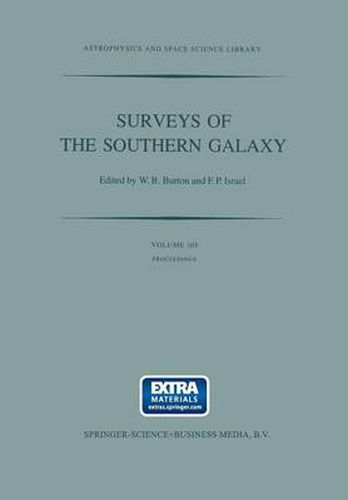Readings Newsletter
Become a Readings Member to make your shopping experience even easier.
Sign in or sign up for free!
You’re not far away from qualifying for FREE standard shipping within Australia
You’ve qualified for FREE standard shipping within Australia
The cart is loading…






This title is printed to order. This book may have been self-published. If so, we cannot guarantee the quality of the content. In the main most books will have gone through the editing process however some may not. We therefore suggest that you be aware of this before ordering this book. If in doubt check either the author or publisher’s details as we are unable to accept any returns unless they are faulty. Please contact us if you have any questions.
Problems associated with a general scarcity of observations of the southern sky have persisted since the present era of galactic research began some sixty years ago. In his 1930 Halley Lecture A. S. Eddington commented on the observational support given to J. H. Oort’s theory of galactic rotation by the stellar radial velocities measured by Plaskett o 0 and Pearce:
… out of 250 stars only 4 were between 193 and 343 0 galactic longitude [=GBP1: 225 < GBP11 < 15~; a stretch of one-third of the whole circuit was unrepresented by a single star. This is the operation which Kapteyn used to describe as flying with one wing . By mathematical dexterity the required constants of rotation have been extracted from the lopsided data; but no mathematical dexterity can avert the possi bility that the neglected part of the sky may spring an unpleasant sur prise. As a spectator I watch the achievements of our monopterous avia tors with keen enthusiasm; but I confess to a feeling of nervousness when my turn comes to depend on this mode of progression.
During the past few years substantial gains have been made in securing fundamental data on the southern sky. Interpretations based on combined southern and northern surveys are producing a balanced descrip tion of galactic morphology. These matters were discussed at a Workshop held at the Leiden Observatory, August 4-6, 1982, attended by some 60 astronomers from 9 countries.
$9.00 standard shipping within Australia
FREE standard shipping within Australia for orders over $100.00
Express & International shipping calculated at checkout
This title is printed to order. This book may have been self-published. If so, we cannot guarantee the quality of the content. In the main most books will have gone through the editing process however some may not. We therefore suggest that you be aware of this before ordering this book. If in doubt check either the author or publisher’s details as we are unable to accept any returns unless they are faulty. Please contact us if you have any questions.
Problems associated with a general scarcity of observations of the southern sky have persisted since the present era of galactic research began some sixty years ago. In his 1930 Halley Lecture A. S. Eddington commented on the observational support given to J. H. Oort’s theory of galactic rotation by the stellar radial velocities measured by Plaskett o 0 and Pearce:
… out of 250 stars only 4 were between 193 and 343 0 galactic longitude [=GBP1: 225 < GBP11 < 15~; a stretch of one-third of the whole circuit was unrepresented by a single star. This is the operation which Kapteyn used to describe as flying with one wing . By mathematical dexterity the required constants of rotation have been extracted from the lopsided data; but no mathematical dexterity can avert the possi bility that the neglected part of the sky may spring an unpleasant sur prise. As a spectator I watch the achievements of our monopterous avia tors with keen enthusiasm; but I confess to a feeling of nervousness when my turn comes to depend on this mode of progression.
During the past few years substantial gains have been made in securing fundamental data on the southern sky. Interpretations based on combined southern and northern surveys are producing a balanced descrip tion of galactic morphology. These matters were discussed at a Workshop held at the Leiden Observatory, August 4-6, 1982, attended by some 60 astronomers from 9 countries.